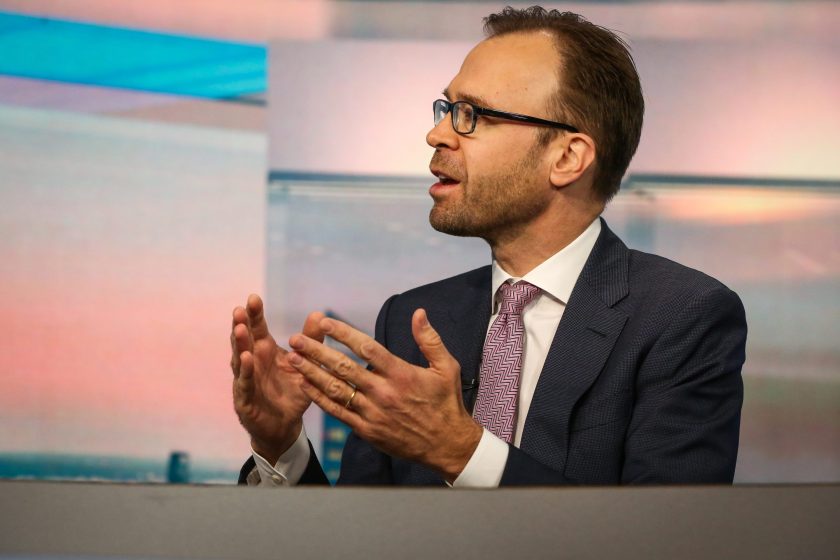

Goldman Sachs chief economist Jan Hatzius believes AI will lead to an increase in long-term U.S. GDP growth. Christopher Goodney—Bloomberg/Getty Images
Goldman Sachs chief economist Jan Hatzius issued a bullish proclamation recently about AI’s effects on the U.S. economy. But Hatzius’s optimistic prediction wasn’t without its warnings, as he acknowledged that the rise of AI could devastate parts of the workforce who would see their jobs replaced.
It’s hardly a new prediction. Anyone who has used widely available AI tools like ChatGPT or Midjourney has seen their immediate ability to replace copywriters or graphic designers. Experts across the spectrum, from economists to academics to international organizations, have also reached similar conclusions through more rigorous analyses, and many, if not all, warn of the imminent disruption to the job market as AI proliferates.
“It will destroy employment in some areas,” Hatzius told CNN in an interview. “There will be parts of the labor market where tasks can be replaced. And to a degree, that is going to result in reduced employment there.”
Hatzius has a strong track record of predicting the path of the U.S. economy. In 2022 he made a very early prediction that the U.S. would pull off the rare “soft landing” that turned out right, and back in 2008 NBC News called his prediction about the imminent crash of the financial sector the “most accurate.” At the time, that made him a rather pessimistic economist, rather than an optimistic one. Now, he’s calling for a bullish outlook on the future of the U.S. economy thanks to AI, but one that won’t be without some near-term turbulence in the labor market.
Last March, an analysis by Goldman Sachs found that some 300 million jobs in the U.S. and Europe could be impacted by AI. The International Monetary Fund also predicted that AI would change many economies, estimating that 60% of jobs in developed economies and 40% of jobs across the globe will be affected by AI.
Both organizations say that most of those jobs wouldn’t be eliminated altogether, but rather would see certain tasks taken over by automation. Goldman estimates about 25% to 50% of a job’s workload would be replaced.
AI can boost worker productivity
As AI speeds up some parts of workers’ jobs it could lead to a boost in productivity. A study from MIT Sloan School of Management found that highly skilled workers who used generative AI for the tasks it was best suited to saw their productivity increase 40%. But using AI to boost productivity is a balancing act. The same study found that when workers overextended themselves and used AI for things that were too advanced for it to figure out, productivity dropped by 19%.
Hatzius, too, sees it as a boost for workers. “I see it as a productivity enhancer,” he told CNN. “A large number of workers in the economy will become more productive. That is very, very likely.”
The ripple effects from that increase in productivity will help the entire U.S. economy, according to Hatzius. Over the past few years the U.S. has struggled with middling productivity growth. At the end of 2022 and early 2023 productivity fell at some of the highest rates in decades. Some of those declines could be attributed to the particularly strong labor market which meant there were many workers, working long hours, but without necessarily delivering an equal increase in output. But productivity ticked up at the end of last year, rising at a 2.7% rate in the fourth quarter of 2023, above a 20-year average.
Worker productivity can turbocharge the U.S. economy
Hatzius is so optimistic that Goldman Sachs recently upped its forecast for the long-term U.S. GDP growth, he told CNN. Already this year the bank raised its U.S. GDP growth forecast from 2.1% to 2.3%, although that was mostly due to a lower risk of inflation than strictly AI-driven productivity gains.
For the full impact of gains to kick in, the U.S. economy will have to wait about five years, Hatzius estimates. He expects most of the country’s AI-induced growth to happen at the end of the 2020s or the start of the 2030s. In fact, Goldman expects that at the earliest, the effects of AI will hit the U.S. GDP in 2027. Widespread use of the technology could lead to a 0.4% GDP boost, Goldman said in November.
Despite the long-term strength he expects AI to deliver for the U.S., Hatzius is aware of the possible turmoil. The country will have to find a way to limit the risks for the many people who will be out of a job, while still capturing the full economic benefits the new technology can offer.
“How that balance is going to work out in the short term, it’s difficult to say,” Hatzius said. “But where I’m much more confident is that it can significantly add to growth over time.”






